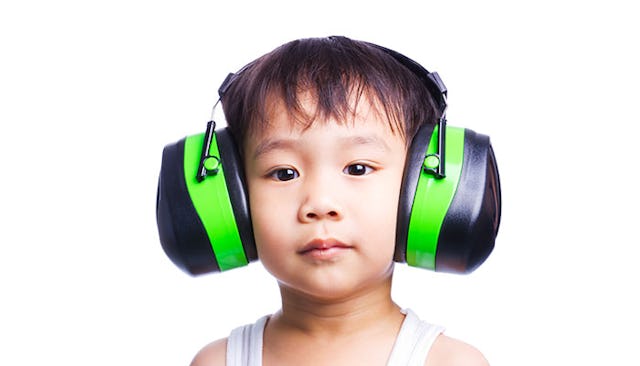Are Earplugs This Generation's Bike Helmet?

When I was growing up, we did not wear bike helmets, sunscreen or even seat belts. And kids often sat in the front seat of the car. Today this behavior seems crazy, given what we now know about the risk of concussions and the permanent damage to our skin that comes from too much sun exposure. Our parents didn’t know the risks, and so they could not protect us.
RELATED: The Best Kids Bike Seats So You & Your LO Can Ride Like The Wind Together
I am sure that today’s generation of parents is making similar mistakes in different areas and that our children will one day look back and wonder why we did not protect them from these dangers. Importantly, there is one risk that we know about and can take action on immediately: to protect our children’s hearing through the use of earplugs.
RELATED: So Your Baby Needs A Helmet? It Will Be Okay, I Promise
We live in an incredibly noisy world, one that seems to get noisier all the time. Whether it is going to a rock concert, a large sporting event or even many restaurants, noise levels are often so high that they can cause hearing loss. Hearing loss is permanent; there is currently no cure, although Hearing Health Foundation and others are working on one. But protection options are readily available, such as wearing earplugs or earmuffs.
This is an immediate problem, as the incidence of teens with hearing loss is already on the rise. A research study published in 2010 in The Journal of the American Medical Association found that in 2005 and 2006, one in five teens had some type of hearing loss, up significantly from one in seven teens in the 1988 to 1994 period. Unfortunately, the prevalence of teen hearing loss is probably even higher today. The ubiquitous earbuds are likely part of the problem, but exposure to dangerous noise levels at concerts, school dance parties and other social events also contribute.
Last year, I clocked the talent show at my children’s elementary school at 90 decibels! Not one child was wearing hearing protection, including my own, only because I had never expected the performance to be so loud. I won’t make that mistake again. The school made no attempt to lower the volume or provide hearing protection; the issue was not top of mind for them. On the other hand, there are strict rules about wearing helmets when riding bikes on school trips.
As a result of the experience with the talent show, I packed earplugs for my children to use at summer camp, just in case there was a similar type of event. Thank goodness I did, because there was a concert at the camp they tell me was incredibly loud. My children wore earplugs and gave out earplugs to some of their friends, but sadly, the camp did not distribute them. I don’t think it crossed the camp director’s mind. By contrast, counselors at the camp are instructed to make sure children wear and reapply sunscreen when playing outside in the sun all day. Hearing protection is just not on their radar yet.
My children see my struggle with my hearing loss every day, so they are very aware of the importance of protecting their hearing. I know that most parents and children probably are not. This makes me wonder: Whose job is it to raise awareness of this important issue? There are several nonprofit organizations on the case, but the work is costly and takes time. They need our help. Those of us with difficulty hearing understand the severe consequences that come with hearing loss, and for that reason, I believe we should help spread the word about the risk of noise-induced hearing loss. We should inform parents and children about ways to protect their hearing. We should write to our local schools and camps. Together, we can help make sure earplugs are not this generation’s bike helmet.
How Loud Is Too Loud? The rule of thumb is that prolonged exposure to any noise at or above 85 decibels can cause gradual hearing loss. This is the level of heavy city traffic or a school cafeteria. At 105 decibels, the maximum volume of most MP3 players, some hearing loss can occur within 15 minutes. At 110 decibels, the level of a rock concert or loud sporting event, damage can occur after one minute. The graphic below from Hearing Health Foundation shows decibel levels for a variety of noises we may encounter in our daily lives.
This article was originally published on